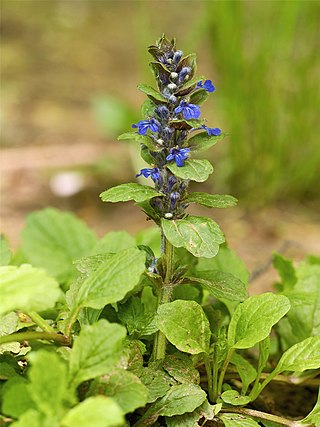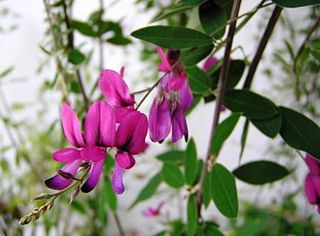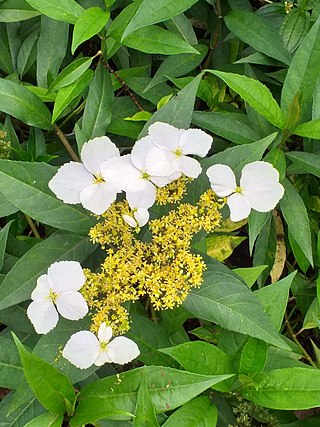
Zygophyllaceae is a family of flowering plants that contains the bean-caper and caltrop. The family includes around 285 species in 22 genera.

Glycyrrhiza is a genus of about 20 accepted species in the legume family (Fabaceae), with a subcosmopolitan distribution in Asia, Australia, Europe, and the Americas.

Daphne is a genus of between 70 and 95 species of deciduous and evergreen shrubs in the family Thymelaeaceae, native to Asia, Europe and north Africa. They are noted for their scented flowers and often brightly coloured berries. Two species are used to make paper. Many species are grown in gardens as ornamental plants; the smaller species are often used in rock gardens. All parts of daphnes are poisonous, especially the berries.

Ajuga, also known as bugleweed, ground pine, carpet bugle, or just bugle, is a genus of flowering plants in the Ajugeae tribe of the mint family Lamiaceae. There are over 60 species of annual or perennial, mostly herbaceous plants. They are native to Europe, Asia, Africa, and Australia.

Nathaniel Lord Britton was an American botanist and taxonomist who co-founded the New York Botanical Garden in the Bronx, New York.

Dasiphora fruticosa is a species of hardy deciduous flowering shrub in the family Rosaceae, native to the cool temperate and subarctic regions of the northern hemisphere, often growing at high altitudes in mountains. Dasiphora fruticosa is still widely referenced in the horticultural literature under its synonym Potentilla fruticosa. Common names include shrubby cinquefoil, golden hardhack, bush cinquefoil, shrubby five-finger, widdy, kuril tea and tundra rose.

Lespedeza is a genus of some 45 species of flowering plants in the pea family (Fabaceae), commonly known as bush clovers or Japanese clovers (hagi). The genus is native to warm temperate to subtropical regions of eastern North America, eastern and southern Asia and Australasia.

Carl Johann Maximovich, also Karl Ivanovich Maximovich was a Russian botanist. Maximovich spent most of his life studying the flora of the countries he had visited in the Far East, and naming many new species. He worked at the Saint Petersburg Botanical Gardens from 1852 as curator of the herbarium collection, becoming Director in 1869.

Androsace, commonly known as rock jasmine, is a genus of flowering plants in the family Primulaceae, second only to Primula in the number of species. It is predominantly Arctic–alpine, with many species in the Himalayas, the mountains of central Asia, the Caucasus, and the southern and central European mountain systems, particularly the Alps and the Pyrenees.

Rheum is a genus of about 60 herbaceous perennial plants in the family Polygonaceae. Species are native to eastern Europe, southern and eastern temperate Asia, with a few reaching into northern tropical Asia. Rheum is cultivated in Europe and North America. The genus includes the vegetable rhubarb. The species have large somewhat triangular shaped leaves with long, fleshy petioles. The flowers are small, greenish-white to rose-red, and grouped in large compound leafy inflorescences. A number of cultivars of rhubarb have been domesticated both as medicinal plants and for human consumption. While the leaves are slightly toxic, the stalks are used in pies and other foods for their tart flavor.

Daphniphyllum is the sole genus in the flowering plant family Daphniphyllaceae and was described as a genus in 1826. The genus includes evergreen shrubs and trees mainly native to east and southeast Asia, but also found in the Indian Subcontinent and New Guinea.

Anaphalis margaritacea, commonly known as the western pearly everlasting or pearly everlasting, is an Asian and North American species of flowering perennial plant in the family Asteraceae.

Hydrangea chinensis is a species of flowering plant in the family Hydrangeaceae, native to Myanmar, southeast China, and Taiwan. It grows in valleys and on mountain tops and slopes.
The Plant List was a list of botanical names of species of plants created by the Royal Botanic Gardens, Kew and the Missouri Botanical Garden and launched in 2010. It was intended to be a comprehensive record of all known names of plant species over time, and was produced in response to Target 1 of the 2002–2010 Global Strategy for Plant Conservation, to produce "An online flora of all known plants". It has not been updated since 2013, and has been superseded by World Flora Online.
Plants of the World Online (POWO) is an online database published by the Royal Botanic Gardens, Kew. It was launched in March 2017 with the ultimate aim being "to enable users to access information on all the world's known seed-bearing plants by 2020". The initial focus was on tropical African Floras, particularly Flora Zambesiaca, Flora of West Tropical Africa and Flora of Tropical East Africa.

Hypericum przewalskii, commonly called Przewalski's St. John's wort, is a flowering plant in Hypericumsect. Roscyna that is native to China.

Hypericum fasciculatum, known as peelbark St. Johnswort or sandweed, is a species of flowering plant in the St. Johnswort family, Hypericaceae, native to the southeastern United States. It is found from eastern North Carolina, south to southern Florida, west to eastern Louisiana. Kew's Plants of the World Online database also notes that it occurs in Cuba, though Cuba is not listed in several other sources. It was first described in 1797 by Jean-Baptiste Lamarck.

World Flora Online is an Internet-based compendium of the world's plant species.

Eriocapitella tomentosa, a species of flowering plant in the buttercup family Ranunculaceae, is native to Asia. The specific epithet tomentosa means "thickly matted with hairs, tomentum (padding)". In Chinese, a common name is da huo cao (大火草), which means "big fire grass" or "great fireweed".
Zanthoxylum piasezkii is a tree from the family Rutaceae.

















